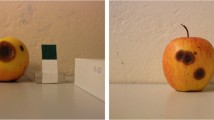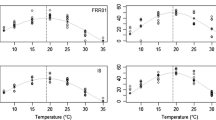Abstract
Apple ring rot, caused by Botryosphaeria dothidea, is one of the most serious diseases affecting apple industry in East Asia. To study the correlation between fruit natural exocarp structures and susceptibility to B. dothidea, lesion length of Malus domestica cultivars and Malus germplasm accessions was measured 14 days after in vitro inoculation with B. dothidea mycelia at different developmental stages. Area per fruit surface (APFS) of lenticels and microcracks and thickness of cuticular wax were observed. Lesion length, lenticel APFS and cuticular wax thickness varied significantly among the 11 cultivars studied. A positive correlation between lesion length and lenticel APFS and a negative correlation between lesion length and cuticular wax thickness were detected among cultivars and during fruit development. In addition, similar correlations were validated in nine Malus germplasm accessions. Numerous microcracks were observed on surfaces of Golden Delicious and Golden Spur fruit, accounting for 90 % of the natural openings. The hyphae of B. dothidea penetrated into exocarp through both lenticels and microcracks. Fruit bagging with double-layered paper bags and exogenous GA4+7 reduced lenticel APFS, thickened cuticular wax and elevated resistance to disease. Natural openings on fruit exocarp are an important factor affecting susceptibility of apple to B. dothidea.










Similar content being viewed by others
Abbreviations
- APFS:
-
Area per fruit surface
- DAFB:
-
Days after full bloom
- LM:
-
Light microscopy
- SEM:
-
Scanning electron microscopy
References
Belding, R. D., Blankenship, S. M., Young, E., & Leidy, R. B. (1998). Composition and variability of epicuticular waxes in apple cultivars. Journal of the American Society for Horticultural Science, 123, 348–356.
Brown, E. A., & Britton, K. O. (1986). Botryosphaeria diseases of apple and peach in southeastern United States. Plant Disease, 70(5), 480–484.
Brown, E. A., & Hendrix, F. F. (1981). Pathogenicity and histopathology of Botryosphaeria dothidea on apple stems. Phytopathology, 71, 375–379.
Chen, Z., Wang, Y., & Yin, S. (1992). A study on the mechanism of resistance to sheath blight in rice. Scientia Agricultura Sinica, 25(4), 41–46.
Chen, J., Sheng, B., & Liu, K. (1995). Mechanism of apple varieties resistat to lenticel infection by ring rot. Proceedings of Horticultural Society, 94–100.
Conway, W. S. (1992). Calcium treatment and postharvest rot on apple and potato. Plant Disease, 76(4), 329–333.
Curry, E. (2008). Effects of 1-MCP applied postharvest on epicuticular wax of apples (Malus domestica Borkh.) during storage. Journal of the Science of Food and Agriculture, 88, 996–1006.
Curry, E. A., Torres, C., & Neubauer, L. (2008). Preharvest lipophilic coatings reduce lenticel breakdown disorder in ‘Gala’ apples. HortTechnology, 18(4), 690–696.
Eccher, T., & Boffelli, G. (1981). Effects of dose and time of application of GA4+7 on russeting, fruit set and shape of ‘Golden Delicious’ apples. Scientia Horticulturae, 14, 307–314.
Ende, G. V. D. (1974). Cutinolytic enzymes in relation to pathogenesis. Annual Review of Phytopathology, 12, 247–258.
Espelie, K. E. (1980). Composition of suberin-associated waxes from the subterranean storage organs of seven plants. Planta, 148, 468–476.
Faust, M., & Shear, C. B. (1972). Fine structure of the fruit surface of three apple cultivars. Journal of the American Society for Horticultural Science, 97, 351–355.
Grimm, E., Khanal, B. P., Winkler, A., Knoche, M., & Köpcke, D. (2012). Structural and physiological changes associated with the skin spot disorder in apple. Postharvest Biology and Technology, 64(1), 111–118.
Guo, L., Li, J., Li, B., Zhang, X., Zhou, Z., Li, G., et al. (2009). Investigations on the occurrence and chemical control of Botryosphaeria canker of apple in China. Plant Protection, 35(4), 120–123.
Han, J. W., Lee, H. J., Jang, H. I., Hong, K. H., Choi, J. J., Kim, K. Y., et al. (1999). Comparison of skin characteristics between non-bagged and bagged ‘Hosui’ pear (Pyrus pyrifolia Nakai) fruits. Journal of the Korean Society for Horticultural Science, 40(4), 439–442.
Hao, Y., Zhao, Q., Liu, Q., & Li, W. (2011). Effects of them micro-environment inside fruit bags on the structure of fruit peel in ‘Fuji’ apple. Acta Ecologica Sinica, 31(10), 2831–2836.
Harker, F. R., & Ferguson, I. B. (1988). Transport of calcium across cuticles isolated from apple fruit. Scientia Horticulturae, 36, 205–217.
Heather, W. A. (1969). Susceptibility of the juvenile leaves of Eucaluplus eucalypti (Hansf) Walker. Australian Journal of Biological Science, 20(4), 769–775.
Kim, S. B., & Kim, S. C. (1989). Pathogenicity and ecology of apple rot caused by Botryosphaeria dothidea III. The comparison to resistance against apple rot among several cultivars. Journal of the Korean Society for Horticultural Science, 30(3), 207–214.
Kim, K. W., Kim, K. R., & Park, E. W. (2005). An infection model of apple white rot based on conidial germination and appressorium formation of Botryosphaeria dothidea. Plant Pathology Journal, 21, 322–327.
Knoche, M., Khanal, B. P., & Stopar, M. (2011). Russeting and microcracking of ‘Golden Delicious’ apple fruit concomitantly decline due to Gibberellin A4+7 application. Journal of the American Society for Horticultural Science, 136(3), 159–164.
Konarska, A. (2012). Differences in the fruit peel structures between two apple cultivars during storage. Acta Scientiarum Polonorum-Hortorum Cultus, 11(2), 105–116.
Li, G., Shen, Y., Gao, Y., Li, X., Gao, S., Wang, J., et al. (2004). Study on the relationship between lenticel tissue structure and density and the occurrence of apple rough bark disease. Journal of Fruit Science, 21(4), 350–353.
Li, G., Gao, Y., Yang, H., Liu, X., Sun, L., & Wang, J. (2005). Observation of infection approach of Botryosphaeria berengriana f. piricola on apple stem under scanning electron microscope. Journal of Fruit Science, 22(2), 169–171.
Li, G., Shen, Y., Gao, Y., Chen, J., & Yan, Z. (2006). Infection process of Botryosphaeria dothidea in apple fruit. Journal of Fruit Science, 23(1), 69–72.
Li, C., Li, C., Zhang, X., & Huo, J. (2009). Advances in research on mechanism of apple resistance to ring rot disease and breeding. China Fruits, 3, 46–49.
Li, F., Zhang, X., Yao, Y., Sun, X., & Liu, L. (2011). Whole fruit staining with aniline blue at harvest is associated with superficial pathogenesis of “Fuji” apples after storage. Biotechnic & Histochemistry, 86(6), 394–403.
Liang, X., Zhou, G., & Pan, R. (2003). Wax and cuticle of peanut seed coat in relation to infection and afiatoxin production by Asperillus flavus. Journal of Tropical and Subtropical Botany, 11(1), 11–14.
Liu, H., Li, C., Fan, Y., & Hou, B. (2003). Correlative analysis of resistance-related factors in apple fruits to apple fruit ring rot disease. Journal of Agricultural University of Hebei, 26(1), 56–60.
Liu, D., Zeng, Q., Ji, Q., Liu, C., Liu, S., & Liu, Y. (2012). A comparison of the ultrastructure and composition of fruits cuticular wax from the wild-type ‘Newhall’ navel orange (Citrus sinensis [L.] Osbeck cv. Newhall) and its glossy mutant. Plant Cell Reports, 31, 2239–2246.
Mendgen, K., Schneider, A., Sterk, M., & Fink, W. (1988). The differentiation of infection structures as a result of recognition events between some biotrophic parasites and their hosts. Journal of Phytopatholohy, 123(3), 259–272.
Peng, Y., & Zhang, D. (2000). Ultrastructure of epidermis and flesh of the developing apple fruit. Acta Botanica Sinica, 42(8), 794–802.
Prusky, D., Fuchs, Y., & Yanko, U. (1983). Assessment of latent infections as a basis for control of post-harvest disease of mango. Plant Disease, 67(7), 816–818.
Roy, S., Conway, W. S., Watada, A. E., Sams, C. E., Erbe, E. F., & Wergin, W. P. (1994a). Heat treatment affects epicuticular wax structure and postharvest calcium uptake in ‘Golden Delicious’ apples. HortScience, 29(9), 1056–1058.
Roy, S., Watada, A. E., Conway, W. S., Erbe, E. F., & Wergin, W. P. (1994b). Low-temperature scanning electron microscopy of frozen hydrated apple tissues and surface organisms. HortScience, 29, 305–309.
Roy, S., Conway, W. S., Watada, A. E., Sams, C. E., Erbe, E. F., & Wergin, W. P. (1999). Changes in the ultrastructure of the epicuticular wax and postharvest calcium uptake in apples. HortScience, 34(1), 121–124.
Sun, Y., Yu, Q., & Xu, J. (2011). Relationship between lenticel tissue structure and the resistance to Botryosphaeria berengeriana f. piricola on apple stem. Journal of Agricultural University of Hebei, 34(06), 55–59.
Tang, W., Ding, Z., Zhou, Z., Wang, Y., & Guo, L. (2012). Phylogenetic and pathogenic analyses show that the causal agent of apple ring rot in china is Botryosphaeria dothidea. Plant Disease, 96(4), 486–496.
Turketti, S. S., Curry, E., & Lötze, E. (2012). Role of lenticel morphology, frequency and density on incidence of lenticel breakdown in ‘Gala’ apples. Scientia Horticulturae, 138, 90–95.
Veraverbeke, E. A., Verboven, P., Oostveldt, P. V., & Nicola, B. M. (2003). Prediction of moisture loss across the cuticle of apple (Malus sylvestris subsp. mitis (Wallr.)) during storage. Postharvest Biology and Technology, 30(1), 75–88.
Wilson, C. L., Pusey, P. L., & Otto, B. E. (1981). Plant epidermal sections and imprints using cyanoacrylate adhesives. Canadian Journal of Plant Science, 61, 781–783.
Yan, Z., Zhang, Q., Zhang, S., Zhou, Z., Guo, G., & Wang, Z. (2005). Identification of apple cultivars for their resistance to ring rot disease. Journal of Fruit Science, 22(6), 654–657.
Yang, L., Zhuang, Y., Wang, Y., Zhang, X., & Han, Z. (2012). The ultrastructural changes of apple fruit with different resistance infected by Botryosphaeria dothidea. Acta Horticulturae Sinica, 39(5), 963–969.
Zhang, H., Wang, S., Mou, Q., Jiang, M., & Sun, F. (1996). Effect of bagging on the peel structure and PPO, POD activity of Pyrus bretschneideri. Acta Horticulturae Sinica, 23(1), 23–26.
Zhang, Y., Wang, K., Wang, Y., Han, Z., Gao, Y., Xu, X., et al. (2010). Evaluation of resistance to fruit ring rot for apple germplasms. Acta Horticulturae Sinica, 37(4), 539–546.
Zhuang, Y., Liu, H., Li, C., Wang, Y., Zhao, Y., Chen, D., et al. (2011). Inheritance of and molecular markers for susceptibility of Malus domestica. Journal of Phytopathology, 159, 782–788.
Acknowledgments
This project was supported by the National High-Tech R&D Program of China (2011AA001204) and the Key Laboratory of Beijing Municipality of Stress Physiology and Molecular Biology for Fruit Trees.
Compliance with Ethical Standards
ᅟ
Conflict of Interest
The authors declare that they have no conflict of interest. The authors also state that a) the paper has not been previously published and is not under consideration by another journal; b) that all authors have agreed with the contents of the manuscript and its submission to this journal; c) all authors listed have contributed significantly to the work and agree to be in the author list.
Author information
Authors and Affiliations
Corresponding author
Rights and permissions
About this article
Cite this article
Guan, Y., Chang, R., Liu, G. et al. Role of lenticels and microcracks on susceptibility of apple fruit to Botryosphaeria dothidea . Eur J Plant Pathol 143, 317–330 (2015). https://doi.org/10.1007/s10658-015-0682-z
Accepted:
Published:
Issue Date:
DOI: https://doi.org/10.1007/s10658-015-0682-z




